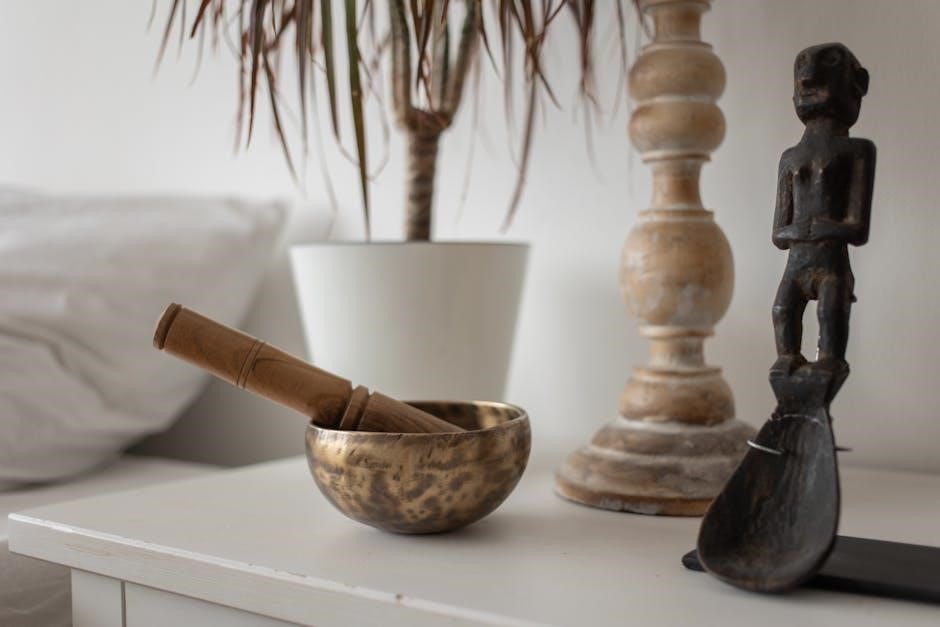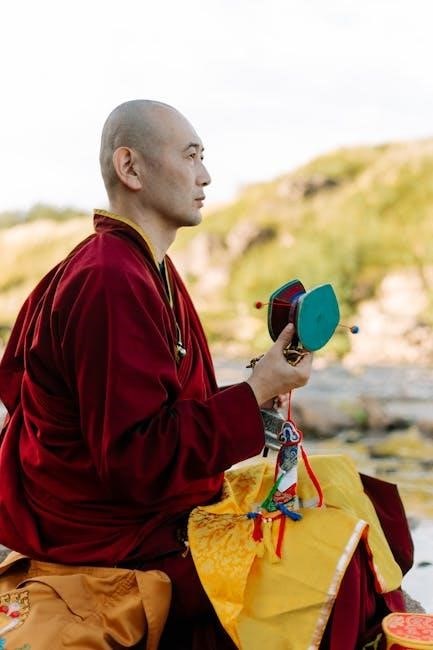
5 tibetan rites pdf

The Five Tibetan Rites are an ancient practice of five exercises believed to promote vitality, longevity, and spiritual balance. Discovered by Colonel Bradford in a Himalayan monastery, these rites were popularized by Peter Kelder in his book Ancient Secret of the Fountain of Youth. They are practiced worldwide for their anti-aging benefits, energy enhancement, and chakra alignment, offering a holistic approach to physical, mental, and spiritual well-being.
What Are the 5 Tibetan Rites?
The Five Tibetan Rites are a series of five simple, flowing exercises practiced to promote physical vitality, mental clarity, and spiritual balance. Originating from Tibetan monks, these rites are designed to energize the body’s chakras, improve flexibility, and enhance overall well-being. Each rite is performed in a specific sequence, typically repeated up to 21 times, to restore energy flow and rejuvenate the body. Popularized in Peter Kelder’s book, Ancient Secret of the Fountain of Youth, they are widely embraced for their anti-aging and rejuvenating properties.
Historical Background and Origins
The Five Tibetan Rites trace their origins to Tibetan monks in the Himalayas, who practiced these exercises for centuries to maintain vitality and longevity. Discovered by British Colonel Bradford in the early 1900s, the rites were later popularized by Peter Kelder in his 1939 book, The Original Five Tibetan Rites. These exercises were believed to enhance energy flow, align chakras, and promote youthful vigor, becoming a cornerstone of ancient Tibetan wellness practices embraced globally for their rejuvenating and anti-aging benefits.

The Origins of the 5 Tibetan Rites
The Five Tibetan Rites originated in ancient Tibet, practiced by monks to maintain youthful vitality. Colonel Bradford discovered them in a Himalayan monastery and shared them globally.
Colonel Bradford and the Himalayan Monastery
Colonel Bradford, a British army officer, discovered the Five Tibetan Rites during his stay in a remote Himalayan monastery in the early 1900s. The monks practiced these exercises to maintain vitality and longevity. Bradford learned the rituals and brought them back to the West, sharing their transformative effects with others. His encounters laid the foundation for the rites’ global popularity, as they were later detailed in Peter Kelder’s book Ancient Secret of the Fountain of Youth.
Peter Kelder and the Publication of the Rites
Peter Kelder introduced the Five Tibetan Rites to the Western world through his 1939 book, The Eye of Revelation. He revealed the exercises as a “Fountain of Youth,” detailing their potential to rejuvenate and align the body’s energy. Kelder’s work popularized the rites globally, emphasizing their anti-aging and health benefits. His writings have inspired millions to adopt the practice, making it a cornerstone of modern wellness routines focused on vitality and longevity.
Benefits of Practicing the 5 Tibetan Rites
The Five Tibetan Rites offer anti-aging benefits, boosting energy, and balancing chakras. They enhance physical strength, mental clarity, and spiritual vitality, promoting overall well-being through holistic practice.
Physical Benefits: Strength, Flexibility, and Energy
Practicing the Five Tibetan Rites enhances physical strength, particularly in the core and major muscle groups. The exercises improve flexibility by stretching the spine, neck, and joints. Regular practice increases energy levels by stimulating blood flow and oxygenation of the body. The rites also tone muscles, improve posture, and support overall physical resilience. By incorporating these movements, individuals can experience a noticeable boost in vitality and physical well-being, making the practice ideal for those seeking a holistic approach to health and longevity.
Mental and Emotional Benefits: Stress Reduction and Clarity
The Five Tibetan Rites offer profound mental and emotional benefits, including reduced stress and enhanced clarity. By aligning the chakras, these exercises promote emotional balance and calmness. The meditative nature of the rites helps quiet the mind, reducing anxiety and fostering focus; Regular practice is known to improve mental acuity and reduce emotional turmoil, leaving practitioners feeling centered and mentally refreshed. This holistic approach to well-being supports a peaceful and resilient mindset, essential for navigating life’s challenges with ease and clarity.
Spiritual Benefits: Chakra Alignment and Vitality
The Five Tibetan Rites are believed to enhance spiritual well-being by aligning the chakras, which are vital energy centers in the body. This alignment is thought to restore the natural flow of energy, promoting vitality and inner harmony. Practitioners report heightened spiritual awareness, as the rites are said to cleanse and balance the chakras, fostering a deeper connection to one’s essence. Regular practice is also believed to amplify life force energy, leading to a sense of renewal and profound spiritual clarity, making it a powerful tool for holistic transformation and enlightenment.
The Five Tibetan Rites Explained
The Five Tibetan Rites are a series of five simple yet powerful exercises designed to promote energy flow and balance in the body. Each rite targets specific aspects of physical, mental, and spiritual well-being, fostering overall vitality and harmony. Originating from ancient Tibetan practices, these exercises are believed to enhance longevity, rejuvenate the body, and align the chakras, offering a holistic approach to health and wellness for practitioners worldwide.
Rite #1: The Spin
Rite #1: The Spin is the foundation of the Five Tibetan Rites. It involves spinning with arms outstretched and eyes focused on a fixed point. Start with 3-5 spins, gradually increasing to 21. The direction of the spin mirrors water draining from a sink. Proper posture and alignment are crucial. This rite is believed to stimulate the first and second chakras, enhancing energy flow and vitality. It also improves balance, coordination, and mental clarity. Consistent practice is key to maximizing its rejuvenating effects.
Always practice on an empty stomach and consult a healthcare professional before starting.
Rite #2: The Leg Raises
Rite #2: The Leg Raises involves lying flat on your back, arms at your sides, and raising your legs straight up toward the ceiling. Slowly lower them back down without letting your feet touch the floor. This rite strengthens the abdominal muscles, improves lower back flexibility, and stimulates the third chakra. It promotes better digestion, posture, and core stability. Practice 21 repetitions, focusing on slow, controlled movements. Modify by bending your knees if needed. This rite enhances physical and energetic balance, supporting overall vitality and well-being.
Consistency is key for optimal results.
Rite #3: The Camel
Rite #3: The Camel involves kneeling with your hands on your hips, arching your chest forward, and tilting your head back. This opens the chest, stretching the shoulders and upper back. It strengthens the neck and spine while stimulating the fourth chakra, which governs love and compassion. Perform 21 repetitions, focusing on deep breathing and maintaining a steady rhythm. The camel pose enhances posture, reduces tension, and promotes emotional balance. Its dynamic movement energizes the body and aligns the chakras for harmonious energy flow.
Practice with controlled movements for maximum benefit.
Rite #4: The Tabletop
Rite #4: The Tabletop begins by sitting with knees bent and feet flat on the floor. Place your hands beside your hips, fingers pointing forward. Inhale deeply, then exhale as you lift your torso, straightening your arms and legs. This pose strengthens the abdominal muscles, improves digestion, and aligns the third chakra, which governs personal power and self-esteem. Perform 21 repetitions, maintaining controlled movements to maximize core engagement and energetic balance. Regular practice enhances posture, reduces belly fat, and boosts vitality.
Focus on steady breathing for optimal results.
Rite #5: The Dog and Cat
Rite #5: The Dog and Cat combines two poses to promote spinal flexibility and emotional balance. Start on hands and knees. Arch your back, lift your head and tailbone (Cat Pose), then round your spine, tuck your chin, and pull your navel toward your spine (Dog Pose). Repeat 21 times. This rite improves posture, relieves tension, and aligns the sixth chakra, enhancing intuition. Focus on synchronized breathing to amplify its rejuvenating effects on the nervous system and overall well-being.
Practice smoothly to maximize benefits.

Proper Breathing Techniques for the Rites
Cleansing breaths are essential for the rites. Inhale deeply through the nose, fill the lungs, then exhale slowly through pursed lips. This practice purifies energy, enhances vitality, and prepares the body for the exercises, promoting a balanced flow of life force.
Regular synchronized breathing ensures optimal energy flow and maximizes the rites’ rejuvenating effects on the body and mind.
The Importance of Cleansing Breaths
Cleansing breaths are a fundamental component of the Five Tibetan Rites, designed to purify and balance the body’s energy. By inhaling deeply through the nose and exhaling slowly through pursed lips, practitioners release stagnant energy, restore vitality, and align their chakras. This breathing technique enhances the rites’ rejuvenating effects, promoting physical and spiritual harmony. Regular practice of cleansing breaths prepares the body for the exercises, ensuring optimal energy flow and maximizing their anti-aging and healing benefits. It is a simple yet powerful tool for maintaining vibrant health and longevity.


Practice Guidelines for the 5 Tibetan Rites
Consistency is key to harnessing the benefits of the Five Tibetan Rites. Practitioners should aim to perform each rite 21 times daily, gradually increasing as comfort allows. Proper breathing, focus, and alignment ensure effectiveness, while listening to the body prevents overexertion. Regular practice fosters vitality, balance, and longevity, aligning with the ancient monks’ tradition of youthful living.
Recommended Daily Routine and Duration
Practicing the Five Tibetan Rites daily is essential for maximum benefits. Start with 3-5 repetitions of each rite and gradually increase to the recommended 21 repetitions. The entire routine takes about 10-15 minutes once familiar. Consistency is key, as it helps align the chakras, boost energy, and promote longevity. Begin slowly, focus on proper breathing, and maintain good posture to avoid injury. Over time, the body adapts, and the practice becomes a rejuvenating habit, fostering vitality and balance.
Preparing for Practice: Safety Tips
Before starting the Five Tibetan Rites, warm up with light stretching to prevent muscle strain. Begin slowly, especially if new to the practice, and listen to your body. Use a mat for comfort and ensure ample space. Avoid practicing on a full stomach or when dehydrated. Wear loose, comfortable clothing and remove jewelry that may interfere with movement. If you have injuries or medical conditions, consult a healthcare professional. Focus on proper breathing and posture to maximize benefits and minimize risk. Gradual progression ensures a safe and effective practice.

Combining the Rites with Other Practices
The Five Tibetan Rites can be enhanced by incorporating complementary practices like yoga, meditation, or breathwork. Adding gentle stretches or mindfulness exercises before or after the rites can deepen relaxation and alignment. Some practitioners integrate journaling or visualization to amplify spiritual benefits. Combining the rites with a balanced diet and regular hydration further supports vitality. For optimal synergy, consider pairing the rites with grounding techniques or nature walks to enhance overall well-being. This holistic approach allows for a more integrated and transformative experience.

Advanced Variations and Modifications
Advanced practitioners can evolve the Five Tibetan Rites by increasing repetitions, incorporating dynamic movements, or adding preparatory postures. The T5T method offers a structured approach to progression, ensuring readiness for advanced levels while maintaining alignment and energy flow.
Intermediate and Advanced Levels of Practice
For intermediate and advanced levels, the Five Tibetan Rites can be enhanced by gradually increasing repetitions beyond 21 or incorporating dynamic variations. Practitioners may add preparatory postures or breathing techniques to deepen the practice. The T5T method offers a structured progression, ensuring that individuals build strength and energy flow safely. Advanced levels focus on mastering the finer details of alignment and breath, allowing for a more profound connection to the chakras and vitality. This approach ensures continuous growth and adaptation to the practice.

Resources for Learning the 5 Tibetan Rites
Various resources, including PDF guides like The Eye of Revelation and online tutorials, provide detailed instructions and visual demonstrations for mastering the Five Tibetan Rites. Communities and step-by-step guides further support practitioners in understanding and refining their practice.
PDF Guides and Books on the Topic
Detailed PDF guides and books like The Ancient Secret of the Fountain of Youth by Peter Kelder offer comprehensive instruction on the Five Tibetan Rites. These resources provide step-by-step descriptions, photographs, and breathing techniques to enhance practice. The Eye of Revelation is another notable book, detailing the exercises and their historical origins. Many PDFs are available online, including free downloads, making it easy for practitioners to access and follow the rituals. These materials are invaluable for understanding the philosophy and proper execution of the rites.
Online Tutorials and Communities
Online platforms offer extensive resources, including video tutorials and guides, to master the Five Tibetan Rites. Websites and YouTube channels provide step-by-step instructions, while forums and social media groups foster communities for sharing experiences. Many enthusiasts and instructors post detailed demonstrations, emphasizing proper form and breathing techniques. These digital tools make learning accessible and engaging, allowing practitioners to connect globally and deepen their understanding of the rites.